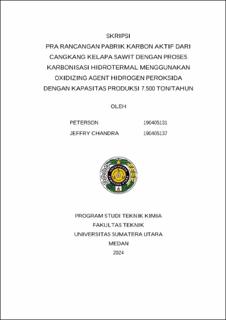| dc.description.abstract | Indonesia is one of the largest producers of Crude Palm Oil (CPO) in the world.
The substantial amount of CPO produced in Indonesia generates significant waste, including solid waste in the form of palm kernel shells. Recycling palm kernel shell waste is aimed at adding economic value, with one of the outcomes being activated carbon. Activated carbon is solid carbon with a high surface area ranging from 500 to 2,500 m2/g, available in powder or granular form, which enables it to exhibit excellent adsorption capacity for vapors or solutions. The primary objective of this preliminary plant design is to provide a technical and economic overview of establishing an activated carbon production plant in Indonesia using hydrogen peroxide as an oxidizing agent. The carbonization process in this design utilizes hydrothermal carbonization, operating in a hydrothermal reactor at a temperature of 200 °C and a pressure of 20 bar. The activation process employs chemical activation using phosphoric acid (H3PO4) as the activator. The selected processes aim to produce activated carbon with large pore sizes, thereby enhancing the product's market value. Based on the economic analysis, the plant requires a total capital investment of Rp. 512,300,866,077.36
and an annual operating cost of Rp. 325,887,022,279.72. With an annual sales revenue of Rp. 448,645,580,599.75, the plant is projected to generate an annual net profit of Rp. 74,359,409,762.61, with a profit margin of 16.57%, a break-even point of 40.55%, a return on investment (ROI) of 14.51%, a return on network (RON) of 24.19%, a payback period of 6.89 years, and an internal rate of return (IRR) of 13.17%. Based on these results, the preliminary design of the activated carbon plant is deemed feasible for further study. | en_US |


